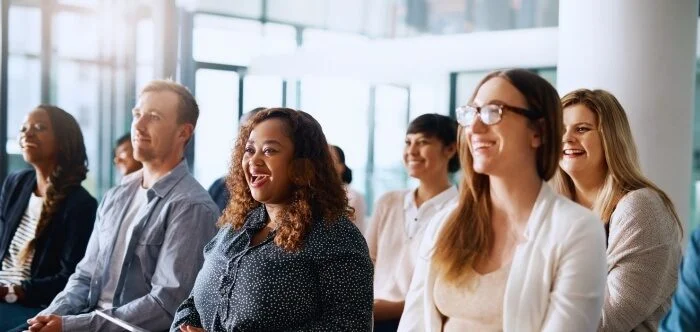Designing an effective conference agenda is a complex process that requires balancing education, engagement, and networking opportunities. The challenge lies in combining these elements smoothly to create a memorable experience. So, how do you structure a conference agenda?
It’s all about combining keynote speeches, panel discussions, and interactive workshops interspersed with ample networking breaks. This approach ensures a dynamic mix of learning, participation, and social interaction. Kick off your event with high-impact sessions that captivate your audience, and conclude with a memorable closing that leaves a lasting impression.
To learn the details behind this complex balancing act and learn how to create an agenda that resonates with every attendee, keep reading our insightful guide that explains the complexities of conference planning.
Quick Overview of Conference Structure
When planning a conference, organizers must carefully structure each element to ensure a seamless and engaging experience for attendees. This includes selecting a theme, scheduling speakers, and arranging sessions that align with the event’s overall objectives. A well-planned structure helps maintain the conference flow and keeps participants engaged throughout the event.
Balancing different aspects, such as networking opportunities, workshops, and keynote presentations, is essential. Each part of the event should complement the others, creating a comprehensive experience that meets attendees’ expectations. Effective time management and logistical planning play key roles in achieving this balance and ensuring smooth transitions between sessions.
A clear agenda allows attendees to navigate the event efficiently, making the most of their time. Organizers must ensure that every session fits perfectly into the schedule, providing opportunities for learning and interaction. This structured approach is especially important for global events like international conference in Canada, where diverse topics, speakers, and participants require careful coordination to enhance the overall experience.
Different Types of Conference Structures
Conferences come in various formats, each suited for specific goals and audiences. Being aware of these structures is key to designing an effective event. Here, we explore the different types of conference structures:
Traditional Conference Structure
The traditional structure focuses on presentations and keynote speeches by industry experts. It’s ideal for sharing knowledge and the latest industry developments. Networking opportunities are often scheduled during breaks or social events. This format suits audiences looking for knowledge from established voices in their field.
Panel-Based Structure
In this format, panels of experts discuss various topics, providing diverse perspectives. Attendees engage through Q&A sessions, increasing the learning experience. This structure encourages dialogue and debate, making it great for collaborative fields. It’s particularly effective at exploring complex issues in depth.
Workshop-Centric Structure
Hands-on learning and active participation are the main features of this workshop structure. They’re ideal for skill development and the practical application of concepts. This format works well in industries where practical skills are as important as theoretical knowledge. It creates an environment of learning by doing.
Hybrid Conference Structure
Combining in-person and virtual elements, hybrid conferences offer flexibility and wider accessibility. They reach out to a global audience, transcending geographical limitations. This structure is becoming increasingly popular, especially in a world where digital connectivity is paramount. It’s ideal for maximizing reach and inclusivity.
There is much more to conferences than just talks; they are opportunities for learning, connecting, and growing. Choosing the right structure is crucial to creating an environment that connects with the audience and fulfills the event’s objectives.
How Do You Structure a Conference Agenda?
Creating a conference agenda is a meticulous process that requires thoughtful planning and a clear understanding of the event’s goals. It’s about finding the right balance between informative sessions and networking opportunities. This step-by-step guide will help you structure a conference agenda effectively.
Step-1. Define the Conference Objectives
A successful conference begins with the identification of the key objectives of the conference. The overall structure and content of an agenda should reflect what you want your attendees to gain from the conference.
Step-2. Select Keynote Speakers
Your conference keynote speakers should be influential and aligned with the theme of your conference. Their presentations should inspire and set the tone for the day. Keynote speeches are often scheduled right at the beginning of the event so that attendees are fully engaged.
Step-3. Organize Panel Discussions
The panel discussion can be an excellent way of providing diverse perspectives on relevant topics. Panel discussions promote interactive dialogue among participants offer varied perspectives and are ideal for exploring complex topics with a variety of viewpoints.
Step-4. Schedule Workshops
To ensure engagement among the attendees during the conference, workshops should focus on hands-on learning, practical application, active participation, and skill development. You can plan these sessions throughout the conference to continue engaging attendees throughout.
Step-5. Allocate Time for Networking
Having breaks and social events included in your schedule is an important part of facilitating connections among attendees. These times also give attendees the chance to step back and reflect on the session that they have attended.
Step-6. Plan a Memorable Closing
A strong closing session can either be a final keynote speech or a summary of the key takeaways from your conference. A memorable closing leaves a lasting impression on your audience and will help you secure attendance in future conferences.
Structuring a conference agenda is the result of creative thinking and strategic planning. Each step plays an important role in crafting an engaging and meaningful experience for the attendees. In that case, conference planning committees should consider these steps to design an agenda that not only informs but also inspires.
Benefits of Having a Good Conference Structure
Designing a well-structured conference is crucial to achieving the desired impact and attendee satisfaction. It’s not just about what is presented, but how it’s organized and delivered. A good conference structure can turn a simple gathering into a powerhouse of knowledge and networking.
Improve Learning Experience
A carefully structured conference maximizes the learning experience for attendees. It ensures that content is delivered in an engaging and understandable manner. This structure helps in better learning of information and a deeper understanding of the topics. Participants leave feeling enriched and informed.
Increased Attendee Engagement
Attendee engagement is enhanced by a good structure. Interactive elements like workshops and Q&A sessions keep the audience involved. This engagement is crucial for a lively and memorable conference experience. It also encourages attendees to actively participate rather than passively listen.
Effective Time Management
The ability to effectively use time as a conference participant is one of the characteristics of a well-structured conference. Balanced agendas prevent schedule delays and unnecessary disruptions by ensuring each session begins and ends on time. This reliability improves the overall conference experience as a result.
Networking Opportunities
Structured networking breaks are essential to a successful conference. They provide valuable opportunities for attendees to connect and collaborate. Such interactions can lead to professional growth and new partnerships. A good structure ensures these networking sessions are well-timed and productive.
Positive Lasting Impression
A well-structured conference leaves a positive lasting impression. It demonstrates professionalism and attention to detail. Attendees are more likely to recommend and return to future events. This reputation is invaluable for sustaining and growing the conference over time.
The benefits of a good conference structure extend beyond the event’s duration. Whether you’re planning a one-day conference or a multi-day event, it will improve professional development and community building. A well-planned conference not only educates but also inspires, leaving attendees eagerly anticipating the next one.
Tips to Identify the Perfect Structure for a Conference
Identifying the ideal structure for a conference is crucial to its success. It requires careful consideration of the event’s objectives and audience. This guide offers tips to help you determine the most suitable structure for your conference.
- Know Your Audience: Know the demographics and interests of your attendees. Adapting the structure to their preferences and professional backgrounds is key to engagement.
- Clarify Conference Goals: Define what you want to achieve. Whether it’s networking, education, or collaboration, your goals should shape the conference’s structure.
- Consider Speaker Line-Up: The selection of speakers can influence the structure. High-profile speakers might suit a keynote-focused format, while experts can facilitate workshops.
- Analyze Venue Limitations: The chosen venue can impact the feasible structure. Consider its size, layout, and facilities when planning the event’s format.
- Balance Content and Networking: Ensure a mix of educational and interactive sessions with ample networking opportunities. This balance keeps attendees engaged and satisfied.
- Take into consideration Time and Resources: Be realistic about the time and resources available. These factors will affect the complexity and scale of the conference structure.
Determining the perfect structure for a conference is a strategic decision influenced by various factors. By considering these tips, you can design an event that resonates with your audience and achieves your objectives. Remember, a well-structured conference is the foundation of a successful and memorable event.
FAQs About How Do You Structure a Conference Agenda?
Creating a well-structured conference agenda is essential for delivering a successful event. Below are some frequently asked questions that explore additional aspects of structuring a conference agenda to ensure a smooth and impactful experience for all attendees.
How Do You Prioritize Sessions in a Conference Agenda?
The best way to prioritize sessions is to match them with the conference objectives and interests of your audience. Impactful sessions, like keynote speeches, should be scheduled at the beginning or during peak times. Workshops and networking events can be interspersed throughout the day to maintain engagement.
What is the Best Way to Manage Time During a Conference?
Effective time management in a conference agenda requires clear time slots for each session, including transitions and breaks. Avoid overloading the schedule, allowing enough time for networking, Q&A sessions, and unexpected delays. Stick to the planned timeline to ensure a smooth flow.
How Do You Include Networking Opportunities in an Agenda?
Scheduling dedicated breaks, social events, or discussion sessions between formal presentations is one way to incorporate networking opportunities. These breaks should be long enough to allow meaningful conversations without feeling rushed, creating connections that add value to the conference experience.
How Should You Adapt an Agenda for Virtual or Hybrid Conferences?
A virtual or hybrid conference agenda requires shorter sessions, interactive elements, and engaging content. Virtual attendees may have shorter attention spans, so it’s crucial to include regular breaks and interactive features, like polls or Q&A, to keep them engaged.
How Do You Ensure Session Topics Align with Conference Goals?
To ensure session topics align with conference goals, start by clearly defining event objectives. Each session should directly support these goals, whether it’s education, networking, or industry updates. Regularly review and adjust the agenda to keep it focused and relevant.
Last Words
Structuring a conference agenda is a complex task that requires careful attention to detail. “How do you structure a conference agenda?” is a question that shows the importance of understanding your audience, clarifying your goals, selecting appropriate speakers, and balancing content with networking opportunities.
Each element, from keynote speeches to workshops and panel discussions, plays a crucial role in creating an engaging and enriching experience. The choice of venue and efficient time management are also key to ensuring a successful conference.
Missteps in any of these areas can lead to a less impactful event, highlighting the need for precision in planning. By following these guidelines, organizers can design a conference structure that not only educates and inspires but also leaves a lasting positive impression on its attendees.








